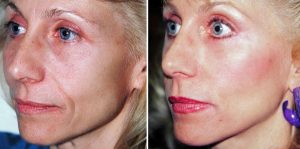Rejuvenation of the aging lower face is done well by classic facelift techniques. And rejuvenation of the upper face is also done well by traditional browlift and blepharoplasty surgery. But the intervening middle of the face, the cheek area, is far more difficult to treat with surgical rejuvenation methods due to surgical access and the facial nerves which run through the cheeks.

In the December 2015 issue of the journal Plastic and Reconstructive Surgery, an article appeared entitled ‘Midcheek Lift Using Facial Soft Tissue Spaces of the Midcheek’. In this paper the authors describe a preperiosteal midcheek lift technique that uses the micheek soft tissue spaces by precise release of its retaining ligaments that separate the spaces. Through a lower subciliary eyelid incision, a skin only lower eyelid flap is raised. This allows the orbicularis muscle to be used as a source of suspension. Through a window into the suborbicularis muscle plane blunt dissection is carried into the preseptal space. From this space dissection is carried into the premaxillary space where the tear trough ligament can be released. Out laterally release of the orbicularis retaining ligament allows entrance into the prezygomatic space where the zygomaticofacial nerve exiting from the bone is seen. Dissection is carried in this plane up to the lateral canthal region. This dissection connects the three soft tissue spaces of the midcheek, the preseptal, premaxillary and prezygomatic spaces. Opening up these spaces allows the overlying orbicularis muscle to be used as a source of traction and suspension for the entire midcheek. The muscle is suspended to the periosteum of the lateral orbital rim to create the cheeklift. Canthopexy was done for lower eyelid support.
Over a five year period, a total of 184 patients were treated with this cheeklift technique. The vast majority of patients (96%) were satisfied with the procedure. A significant rejuvenation of the cheek with elimination of eye bags, elevation of the lid-cheek junction and the cheek prominence and improvement in the depth of the nasoabial folds were seen. Ectropion only occurred in 1% of the patients. Lid retraction occurred in 2% of the patients. Prolonged chemosis occurred in 4% of the patients.
This cheeklift technique goes above the periosteum as opposed to below it as is traditionally done. It is a safe dissection that can be done rapidly and mobilizes the cheek tissues using the soft tissue spaces between the retaining ligaments. Like all cheeklifts the risk of lower eyelid malposition and etropion can occur. Prevention through lateral canthopexies and avoiding to much lower eyelid skin removal is important.
Dr. Barry Eppley
Indianapolis, Indiana


